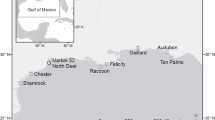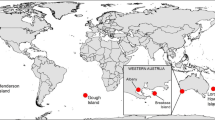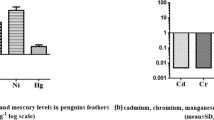Abstract
Levels of environmental pollutants are usually higher in mainland and coastal areas than in offshore or oceanic islands due to higher inputs from agricultural and industrial sources. Levels of heavy metals are usually higher in adult than in young birds, because they have had longer to accumulate metals in their tissues, and/or because they may eat larger, more contaminated, prey. We examined the levels of arsenic, cadmium, chromium, lead, manganese, mercury, and selenium in the adults and young of Bonin petrel (Pterodroma hypoleuca), Christmas shearwater (Puffinus nativitatis) and red-tailed tropicbird (Phaethon rubricauda) on Midway Atoll, and adult wedge-tailed shearwater (Puffinus pacificus) on Midway Atoll and on Manana Island (off Oahu) in the northern Pacific. All birds were analyzed individually except for Christmas Shearwater chicks where samples were pooled to obtain sufficient quantities for analysis. Significant (p<0.05) age-related differences were found for mercury, selenium, manganese and chromium in Bonin petrels, for selenium and mercury in Christmas shearwaters, and for chromium and mercury in Red-tailed Tropicbirds. Lead approached significance for all three species. Adults had higher levels than young except for chromium and manganese in the petrels and arsenic in all three species. There were significant interspecific differences in concentrations of all metals except arsenic for the adults nesting on Midway. Christmas shearwaters had the highest levels of all metals except mercury and chromium. Bonin petrels, the smallest species examined, had mercury levels that were over three times higher than any of the adults of the other three species. For wedge-tailed shearwaters, levels of chromium and lead were significantly higher, and manganese and selenium were lower on Midway than Manana. Knowledge of the foraging ranges and habits of these far-ranging seabirds is inadequately known, but does not currently explain the observed differences among species. We could not find a consistent pattern of differences between the burrow nesting species (Bonin petrel, Wedge-tailed shearwater) and the surface nesting tropicbirds. There was no consistent pairwise correlation between any metals across all species.
Similar content being viewed by others
References
Applequist, H., Askirk, S. and Draback, L.: 1984. ‘Mercury stability in bird feathers’, Mar. Pollut. Bull. 15, 22.
Bache, C. A., Gutenmann, W. H. and Link, D. J.: 1971. ‘Residues of total mercury and methylmercuric salts in lake trout as a function of age’, Science 172, 951.
Braune, B.M.: 1987, ‘Comparison of total mercury levels in relation to diet and molt for nine species of marine birds’, Arch. Environ. Contam. Toxicol. 16, 217.
Braune, B. M. and Gaskin, D. E.: 1987a, ‘A mercury budget for the bonaparte's Gull during autumn moult’, Ornis Scand. 18, 244.
Braune, B. M. and Gaskin, D. E.: 1987b, ‘Mercury levels in Bonaparte's gull (Larus philadelphia) during autumn molt in the Quoddy Region’, New Brunswick, Canada. Arch. Environ. Contam. Toxicol. 16, 539.
Burger, J.: 1993, ‘Metals in avian feathers: bioindicators of environmental pollution’, Rev. Environ. Toxicol. 5, 197.
Burger, J. and Gochfeld, M.: 1995, ‘Biomonitoring of heavy metals in the Pacific Basin using avian feathers’, Environ. Toxicol. Chem. 14, 1233.
Burger, J., Schreiber, E. A. E. and Gochfeld, M.: 1992, ‘Lead, cadmium, selenium and mercury in seabird feathers from the tropical mid-Pacific’, Environ.Tox. Chem. 11, 815.
Burger, J., Pokras, M., Chafel. R. and Gochfeld, M.: 1994, ‘Heavy metal concentrations in feathers of common loons (Gavia immer) in the northeastern United States and age differences in mercury levels’, Environ. Monit. Assess. 30, 1.
Carboneras, C.: 1992, Procellariidae: Petrels and Shearwaters, in: J. del Hoyo, A. Elliott and J. Sargatal (eds), Handbook of the Birds of the WorldVol 1, pp. 216–257, Lynx Edicions, Barcelona.
Clark, L., Ricklefs, R. E. and Schreiber, R.W.: 1983, ‘Nest-site selection by the red-tailed tropicbird’, Auk 100, 953.
Fowler, S. W.: 1990, ‘Critical review of selected heavy metal and chlorinated hydrocarbon concentrations in the marine environment’, Marine Environ. Research 29, 1.
Furness, R. W., Muirhead, S. J. and Woodburn, M.: 1986, ‘Using bird feathers to measure mercury in the environment: relationships between mercury content and moult’, Mar. Pollut. Bull. 17, 27.
Furness, R. W., Lewis, S. A. and Mills, J. A.: 1990, ‘Mercury levels in the plumage of red-billed gulls (Larus novaehollandiae scopulinus) of known sex and age’, Environ. Pollut. 63, 33.
Goede, A. A. and deBruin, M.: 1984, ‘The use of bird feather parts as a monitor for metal pollution’, Environ. Pollut. 8, 281fSwanson
Gould, P. J., King, W. B. and Sanger, G. A.: 1974, ‘Red-tailed tropicbird (Phaethon rubricauda), in Pelagic studies of seabirds in the central and eastern Pacific Ocean (W. B. King, ed.), Smithsonian Contrib. Zool., vol. 158, pp. 206-231.
Grant, G. S., Warham, J., Pettit, T. N. and Whittow, G. C.: 1983, ‘Reproductive behavior and vocalizations of the bonin petrel’, Wilson Bull. 95, 522.
Harrison, C. S.: 1984, 'Terns’, in Seabirds of eastern North Pacific and arctic waters (D. Haley, ed.), Pacific Search Press, Seattle, pp. 146–160.
Harrison, C. S.: 1990, ‘Seabirds of Hawaii’, Cornell Univ. Press, Ithaca, NY.
Harrison, C. S., Hida, T. S. and Seki, M. P.: 1983, ‘Hawaiian seabird feeding ecology’, Wildl. Soc. Wildl. Monogr. No. 85.
Hunter, B. A. and Johnson, J. G.: 1982, ‘Food chain relationships of copper and cadmium in contaminated grassland ecosystems’, Oikos 38, 108.
Lewis, S. A. and Furness, R. W.: 1991, ‘Mercury accumulation and excretion by laboratory reared black-headed gull (Larus ridibundus)’, Arch. Environ. Contam. Toxicol. 21, 316.
Phillips, G. R., Lenhart, T. E. and Gregory, R. W.: 1980, ‘Relation between trophic position and mercury accumulation among fishes from the Tongue River Reservoir’, Environ. Research 22, 73.
Potter, L., Kidd, D. and Standiford, D.: 1975, ‘Mercury levels in Lake Powell: bioamplification of mercury in a man-made desert reservoir’, Environ. Sci. Technol. 9, 41.
SAS (Statistical Analysis Systems): 1985, ‘SAS Users' Guide’, Statistical Institute, Inc., Cary, NC.
Schreiber, E. A. and Schreiber, R. W.: 1993, Red-tailed tropicbird (Phaethon rubricauda), Birds of North America 43, 1.
Seto, N. W. H. and Jansen, P.: 1997, ‘A minature camera system for examining petrel burrows’, J. Field Ornithol. 68, 530.
Sileo, L., and Fefer, S. I: 1987, ‘Paint chip poisoning of laysan slbatross at Midway Atoll’, J. Wildl. Diseases 23, 432.
Swanson, N. M. and Merritt, F. D.: 1974, ‘The breeding cycle of the wedge-tailed shearwater on Mutton Bird Island’ N.S.W. Australian Bird Bander 12, 3.
van Straalen, N. M. and Ernst, E.: 1991, ‘Metal biomagnification may endanger species in critical pathways’, Oikos 62, 255.
Walsh, P. M.: 1990, ‘The use of seabirds as monitors of heavy metals in the marine environment’, in: Heavy metals in the marine environment, R.W. Furness and P. S. Rainbow (eds)., CRC Press, Boca Raton, Florida, pp. 183–204.
Whittow, G. C.: 1997, Wedge-tailed Shearwater (Puffinus pacificus), Birds of North America, No 305:1-24.
Author information
Authors and Affiliations
Corresponding author
Rights and permissions
About this article
Cite this article
Gochfeld, M., Gochfeld, D.J., Minton, D. et al. Metals in Feathers of Bonin Petrel, Christmas Shearwater, Wedge-Tailed Shearwater, and Red-Tailed Tropicbird in the Hawaian Islands, Northern Pacific. Environ Monit Assess 59, 343–358 (1999). https://doi.org/10.1023/A:1006134125236
Issue Date:
DOI: https://doi.org/10.1023/A:1006134125236




